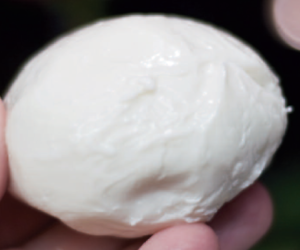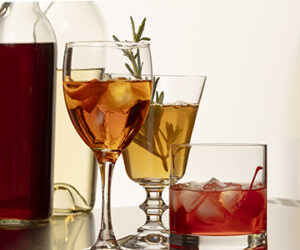
The poets speak of glad hearts, and the red tulips and blossoming trees leave no doubt. Spring is here! So are tender, fresh vegetables like baby asparagus, bell peppers, white corn and tart mixed greens. With these newly available ingredients, you can create a delicious meal that celebrates the arrival of the warm season.
The following menu combines the elegant vegetables of spring with a wide variety of wines from all over the world. For each course, the wine is used both as ingredient and accompanying drink. Warning: These unexpected flavor combinations may break some of the rules for your prized vintages!
Simple Start: Sauteed Shrimp
This appetizer combines classic sweet Sauternes with the natural richness of shrimp and saffron. The dish is best with a medium-mature to mature Sauternes, perhaps 10 years old or more.
Sauternes is a potent wine usually reserved for use with desserts and aperitifs. The Sauternes region of France is located in the heart of Bordeaux, along the Garrone River, north of Langon and east of Barsac. The wine is mostly made from Semillon and Sauvignon Blanc grapes (and sometimes Muscatel), and is cellared with a high content of residual sugar.
Sauternes undergoes a long secondary fermentation during maturation in airlocked casks. This dries out the wine’s finish and pushes the alcohol content upwards of 14 percent. When the secondary is finished, the residual sugar content is still 12 percent.
The saffron threads come from the crocus flower—when dried, they’re a potent source of both flavor and color, similar to flower petals. Used properly, saffron is uniquely suited to seafood ingredients. The leeks also add a fresh quality to shallot and garlic sautes.
We’ll saute the ingredients over high heat, then deglaze and reduce the wine until almost dry. Butter is then added to create an easy beurre blanc (a buttery white sauce) before serving.
Sauternes Saffron Shrimp
4 medium shrimp, peeled and deveined
2 oz. Sauternes
1 tbsp. minced shallot
1 clove fresh garlic, mashed
1/8 cup leek, julienned
small pinch of saffron threads
3 tbsp. butter
Start with one tbsp. of butter in a hot saute pan. Sweat the leek, shallot and garlic. (“Sweat” means to saute the items over a constant medium heat with butter or oil to extract some of the water and soften them). Add shrimp and saffron threads. When cooked almost completely, deglaze the pan with two to three oz. of Sauternes and remove from heat. The wine should be reduced to almost dry. Stir in rest of butter to create a light, smooth beurre blanc. Makes one serving.
Spring Green: Mixed Salad with Sage Croutons
Our salad is relatively basic, but the sage croutons and wine-infused vinaigrette make it come alive with spring flavors. Fresh greens — a mix of greens from a good local grocer including endive, arugula, mustard leaves and other similar varieties — create the best salads. If we match their refreshing qualities and often-tart flavors with the right wine and herbs, we can make the sometimes-overlooked salad course memorable. Adding a small amount of finely grated fontina cheese will help the salad soar!
Most of the time a light, white wine is used in salads, but the balsamic vinegar and fontina are better suited to the deeper, more complex flavors found in reds. The tannic skin qualities — along with the full, bright cherry fruit and plum flavors of Merlot, for example — make red wine an interesting choice for accompanying the salad course.
Mixed Greens with Merlot-Balsamic Vinaigrette
mixed greens
2 tsp. finely grated
fontina cheese
2 oz. balsamic vinegar
2 oz. Merlot
1/4 cup olive oil
1 tbsp. stone ground mustard
small pinch of salt and
black pepper
Combine vinegar, wine and oil in a mixing bowl and whisk well until completely emulsified. This makes about one cup of vinaigrette.
To make the sage croutons, simply cut French or Italian country bread with a round cookie cutter or a small metal ring. Mince fresh sage leaves and sweat in a small amount of butter for a minute or two until tender. Brush the bread disks with the sage butter mixture and broil until evenly browned.
The Pause that Refreshes: Lemon Champagne Sorbet
Our entrement—the palate cleanser—is a light, citric sorbet. The preparation is very easy and the short list of ingredients makes this taste-bud refresher convenient to use with any meal.
Champagne (or any good sparkling wine) is suited to many occasions, not just to holidays and celebrations. Spring and summer menus particularly benefit from Champagne’s high acidity and refreshing carbonation. The type of Champagne doesn’t matter too much, but the drier the better for drinking with the sorbet.
Lemon Champagne Sorbet
4 oz. Champagne
4 oz. heavy cream
4 oz. lemon juice
1 tbsp. white sugar
Combine ingredients in a mixing bowl and gently whip until smooth and thick. The cream should not reach the “soft peak” stage. Place mixture in freeze. Allow to freeze, periodically stirring with a whisk to ensure a smooth, light product. Makes two cups, depending on how much the mixture is whipped.
The Main Event: Pork Tenderloin Adobado
“Adobado” is not a dish as much as a style. It describes food that has been marinated and contains chiles. In this recipe, we use two varieties — mild, flavorful green chiles (California chiles) and hot, red cayenne chiles—to season pork.
The wine for this course is Rioja, a wonderfully fruity Spanish red wine made predominately from the tempranillo grape, and some Garnacho. You’ll find that the Rioja keeps well with the Spanish theme of the adobado.
You’ll also find that the rounded, lighter character of the Garnacho is not overpowering. Rather, it enhances the searing process of both the meat and the roasted chiles while allowing the mild pork flavor to show through.
Like a Beaujolais Nouveau, this entree creates a combination that evokes spring. It’s the ultimate answer to anyone who says pork tenderloin is boring!
Adobado Marinade
8 oz. Rioja wine
1 oz. Worcestershire sauce
1 tsp. ground coriander
Mix all ingredients in a stainless pan or bowl and marinate pork overnight, turning if necessary to evenly expose meat to the marinade. For one tenderloin.
Pork Tenderloin Adobado
1 large pork tenderloin
marinated as above
1 small lime, zested
cilantro to garnish
1/4 cup tomato, diced
1/4 cup onion, julienned
3 scallion stalks, finely diced
1 medium green chile, roasted and minced
1 cayenne chile, roasted
and minced
cumin to coat
paprika to coat
1 tsp. coarse black pepper
1 tsp. salt
1 cup Rioja wine
1 cup marinade liquid
olive oil to brown
Slice open the tenderloin and pound flat. Sprinkle with cumin and paprika (just enough to lightly coat the surface), then stuff with the chiles, tomato and scallion. Roll and tie. Cover with salt and coarse pepper, and brown in hot saute pan. Place in 350° F oven to finish.
Deglaze saute pan with wine, add juice of lime and onion. Reduce to thick consistency. Serve with tenderloin. Makes one tenderloin (about four good servings).
Tomatillo Salsa
6 tomatillos, diced small
1 mango, peeled and
sliced small
cilantro to taste
1 tbsp. chili powder
pinch of salt
Mix in small bowl and refrigerate until needed. Makes four servings to accompany tenderloin.
On the Side: Spring Vegetables and Red Potatoes
The side dishes are roasted red potatoes and wine-steamed spring vegetables. Almost any white wine would work, but a good old California Chardonnay, with a crisp character and underlying buttery notes, makes the vegetables really come together.
Spring vegetables like snow peas, baby carrots, zucchini, bell peppers and button mushrooms are best prepared with cooking methods that don’t overpower the fresh flavors. Steam the vegetables in wine, or quickly saute in light olive oil.
Chive-Roasted Red Potatoes
1 large red potato
olive oil for browning
3 tbsp. finely chopped chives
black pepper and salt to taste
Cut the potatoes lengthwise and brown in olive oil. Coat with salt, pepper and chives. Finish in a 400° F oven.
A Decadent Dessert: Chocolate Port Cake
To finish up the meal on a celebratory note, make a moist chocolate cake, flavored with brandy-fortified port wine and fresh raspberries. The sauce is a vanilla cream with cinnamon — two more flavors that entwine around the alcohol and esters of the port, and also offset the chocolate. It’s a wonderful way to enjoy a relaxing spring night!
Chocolate Port Cake with Raspberries and Cream
2 oz semisweet cocoa powder
8 oz. cake flour
8 oz. sugar
8 oz. eggs
8 oz. butter, softened
4 oz. port wine
raspberries to garnish
Except for the wine, weigh out the ingredients. Mix until even and creamy; the sugar should be dissolved and not grainy. Bake at 375° F for about 30 minutes, or until wooden skewer comes out clean. Cake batter should fill a 10-inch springform pan. When done, invert and cool.
Brush the cake with more port wine before serving. Garnish with fresh berries and the vanilla-cream mixture described below.
Vanilla Cream
1 pint heavy cream
1 vanilla bean, split
cinnamon and sugar to taste
Split the vanilla bean (most chefs take the seeds out, too), then add it to the cream in a saute pan or a shallow pan for reducing. Over medium-high heat, reduce the cream to about half of its original volume. It should be very thick. When warm, it will coat the back of a wooden spoon; when cool, it should hold its place on the plate without running.
Adjust the flavor with cinnamon and sugar when thickened. Take out the vanilla bean, or better yet, strain it before cooling. Refrigerate until needed.
Make Wines to Match the Menu
When making the wines used in this menu, the following tips may help you create the perfect blends for your special meals.
Sauternes
• Use a 75 percent Semillon and 25 percent Sauvignon Blanc blend. In rare instances, two to three percent of Muscatel is also used, and can add extra depth.
• The spirit behind Sauternes’ strength and flavor is in the
harvest. The grapes are allowed to become infected by noble rot and are picked late in the season. They are shriveled and have lost most of their water content, which increases the sugar content. When looking through local vineyards or buying concentrates, make sure you’re getting the real thing.
• The grapes are pressed five times. All of the juice is extracted. A potent yeast should be used and aging is traditionally done in new oak. The alcohol content needs to be a minimum of 13 percent.
• Sauternes should be sweet (particularly if young), but balanced by alcohol and fruit flavors.
Merlot
• Merlot is softer and fruitier than Cabernet. It should be less
tannic, but still possess skin flavors and earthy notes along with some plum and cherry flavors.
• Like many deep red wines, Merlot is dry, round and complex.
• Merlot grapes are often used for blending. It is excellent in
concentrations of 80 percent, and sometimes more. Cabernet Sauvignon, Cabernet Franc and Pinot Noir are good for adding to the fruity flavor of Merlot.
Champagne
• For most food pairings, Champagne should be very dry. The best Champagnes all are. Attenuate the wine thoroughly. For bottle conditioning, use a dosage of about one percent.
• A good Champagne blend to start with is Pinot Noir (56 percent), Chardonnay (28 percent) and Pinot Meunier (16 percent). This mirrors the blend from the Veuve-Cliquot estate.
• More complex fruit flavors and deeper colors can be achieved by using higher portions of Chardonnay. An all-Chardonnay Blanc de Blancs can be a phenomenally good food wine.
Sherry
• A crisp, clean Fino is a good food-pairing sherry.
• Unfortunately, Finos and other sherries can be very difficult to make at home; it takes many years and many steps. Sometimes it’s better just to buy.
• Finos are about 18 percent alcohol by volume. They taste slightly salty and are very crisp for being so potent.
Rioja
• These Spanish reds should be slightly spicy and full of cherry flavors. Smoke and cedar can sometimes be underlying qualities. A fruity, slightly bright wine is the desired result.
• Rioja’s flavors will change greatly depending on the grapes chosen. Higher concentrations of the blackish Tempranillo grape will yield a deeper, black-currant and cherry-accented wine, while more of the Garnacho grape will soften the outcome.
Chardonnay
• Good Chardonnays have oak flavor and some buttery diacetyl from fermentation.
• 100 percent Chardonnay wines have taken the market by storm in the past few years, and for good reason. Like the fine Blanc de Blancs Champagne, 100 percent Chardonnay is chock-full of flavor and color.
• Choose grapes (or extracts from grapes) that have ripened as long as possible, but have not been affected by rains and mold late in the harvest year.
Port
• The key to a good port is good age. Some ports are aged only in oak, while others, the vintage types, are bottle-aged.
• Transfer the port from cask to bottle after the second year, and allow it to mature on its yeast for the duration of its life. While you’re waiting, there is no shortage of good stuff on your local supermarket shelves.
• Choose good grape brandy for fortifying your port, so your efforts will be rewarded as much as possible.
• Remember, a port does not have to be mature to be good with food, although very young ports can be cloyingly sweet.
—Mikoli Weaver
Mikoli Weaver is a freelance writer and brewer in Portland, Oregon. Trained as a professional chef, he’s a regular contributor to WineMaker.







